Chinese scientists have developed a high-speed infrared sensor inspired by the fire beetle. This breakthrough could one day power a new generation of surveillance systems, potentially outmatching the US military’s planned “Golden Dome” missile defense shield.
Researchers from the Shanghai Institute of Technical Physics at the Chinese Academy of Sciences, working with Tongji University, say their newly developed sensor is 20,000 times faster than existing technologies and can detect motion and heat in extreme environments such as smoke, dust, or fog.
Fire beetle-inspired infrared sensor
According to the South China Morning Post, infrared sensing is important for spotting threats when visibility is low.
Military, firefighting, and industrial operations use this technology to track movement, find heat sources, and navigate in the dark.
The Chinese team looked to the fire beetle for inspiration. Using a special heat-sensing organ, this beetle can sense forest fires from hundreds of kilometers away.
This ability helps beetles find the best spots to lay their eggs. Using this idea, Professors Hu Weida and Miao Jinshui led a team to create a transistor.
They used two main materials: palladium diselenide (PdSe₂), which absorbs infrared light well, and pentacene, an organic semiconductor that works like the beetle’s sensory system.
The device works in the mid-infrared range and can detect extremely low heat levels. When tested in simulated wildfire scenarios with temperatures reaching 927 degrees Celsius (1,700°F), the sensor could track flame movement and store heat patterns with nearly 95% accuracy.
This makes it a strong candidate for night vision, fire detection, industrial safety, and defense surveillance.
In a related study, the researchers built a second device using black phosphorus and indium selenide (BP/InSe), which achieved photonic memory speeds of just 0.5 microseconds.
Compared to older devices that captured only blurry signals, this system could store 17 precise data points of infrared targets.
Rival US missile defense plans
The researchers say this speed and clarity could prove useful in military applications like missile defense and high-speed targeting.
The sensors were also tested for real-time memory and image recognition, opening the door to integrating autonomous drones, satellites, or ground-based missile systems.
These could form a highly responsive infrared surveillance network across land, sea, and space.
While no military application has been officially announced, the study suggests that the fire beetle-inspired sensor could be added to Chinese systems like the HQ-17AE missile defense unit, allowing it to intercept threats even in harsh environments such as sandstorms or nighttime battles.
The faster BP/InSe-based chips could support targeting for railguns aboard warships or carriers.
The research comes just months after US President Donald Trump announced the “Golden Dome,” a proposed multibillion-dollar missile shield made of space-based satellites with infrared sensors.
However, those systems would rely on traditional silicon-based sensors, which the Chinese researchers argue cannot match the speed or precision of their new devices.
Recent studies in Nature Communications and Light: Science & Applications show that combining sensing, memory, and processing into a single unit can lower delays, save energy, and allow real-time operations.
These benefits are essential for future drone fleets, self-driving cars, and edge computing in challenging environments.


